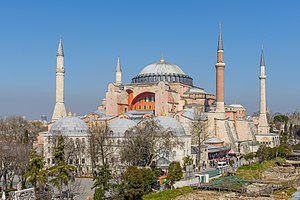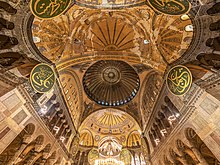Hagia Sophia
Hagia Sophia (Hi-lia̍p-gí: Ἁγία Σοφία, ì-sù: "Sîn-sèng Tì-hūi"), chá-chêng sī Tang-chèng-kàu ê kàu-tn̂g; āu-lâi sī I-su-lân-kàu ê chheng-chin-sī; hiān-sî sī phok-bu̍t-koán. Só͘-chāi tī kin-á-ji̍t ê Istanbul.
|
Ἁγία Σοφία Pang-bô͘:ISO 639 name el iá-bōe chhòng-kiàn Sancta Sapientia (Latin-gú) Ayasofya ([[Türk-gú|Türk-gú]]) | |
 | |
 | |
| Location | Turkey Istanbul Fatih |
|---|---|
| Designer |
Isidore of Miletus Anthemius of Tralles |
| Type |
|
| Material | Ashlar, Roman brick |
| Length | 82 m (269 ft) |
| Width | 73 m (240 ft) |
| Height | 55 m (180 ft) |
| Beginning date | 360 nî |
| Completion date | 537 nî |
| Dedicated to | The Holy Wisdom, a reference to the second person of the Trinity, or Jesus Christ[2] |
| Website | |
| Part of | Historic Areas of Istanbul |
| Criteria | Cultural: i, ii, iii, iv |
| Reference | 356 |
| Inscription | 1985 (Tē-9 session) |


Tsù-kái siu-kái
- ↑ Emerson, William; van Nice, Robert L. (1950). "Hagia Sophia and the First Minaret Erected after the Conquest of Constantinople". American Journal of Archaeology. 54 (1): 28–40. doi:10.2307/500639. ISSN 0002-9114. JSTOR 500639. (Eng-gí)
- ↑ Curta, Florin; Holt, Andrew (2016). Great Events in Religion: An Encyclopedia of Pivotal Events in Religious History [3 volumes] (ēng Eng-gí). ABC-CLIO. p. 299. ISBN 978-1-61069-566-4.
Hagia Sophia was consecrated on December 27, 537, five years after construction had begun. The church was dedicated to the Wisdom of God, referring to the Logos (the second entity of the Trinity) or, alternatively, Christ as the Logos incarnate.
(Eng-gí)
Tsù-kái siu-kái
- Istanbul
| Pún bûn-chiuⁿ sī chi̍t phiⁿ phí-á-kiáⁿ. Lí thang tàu khok-chhiong lâi pang-chō͘ Wikipedia. |